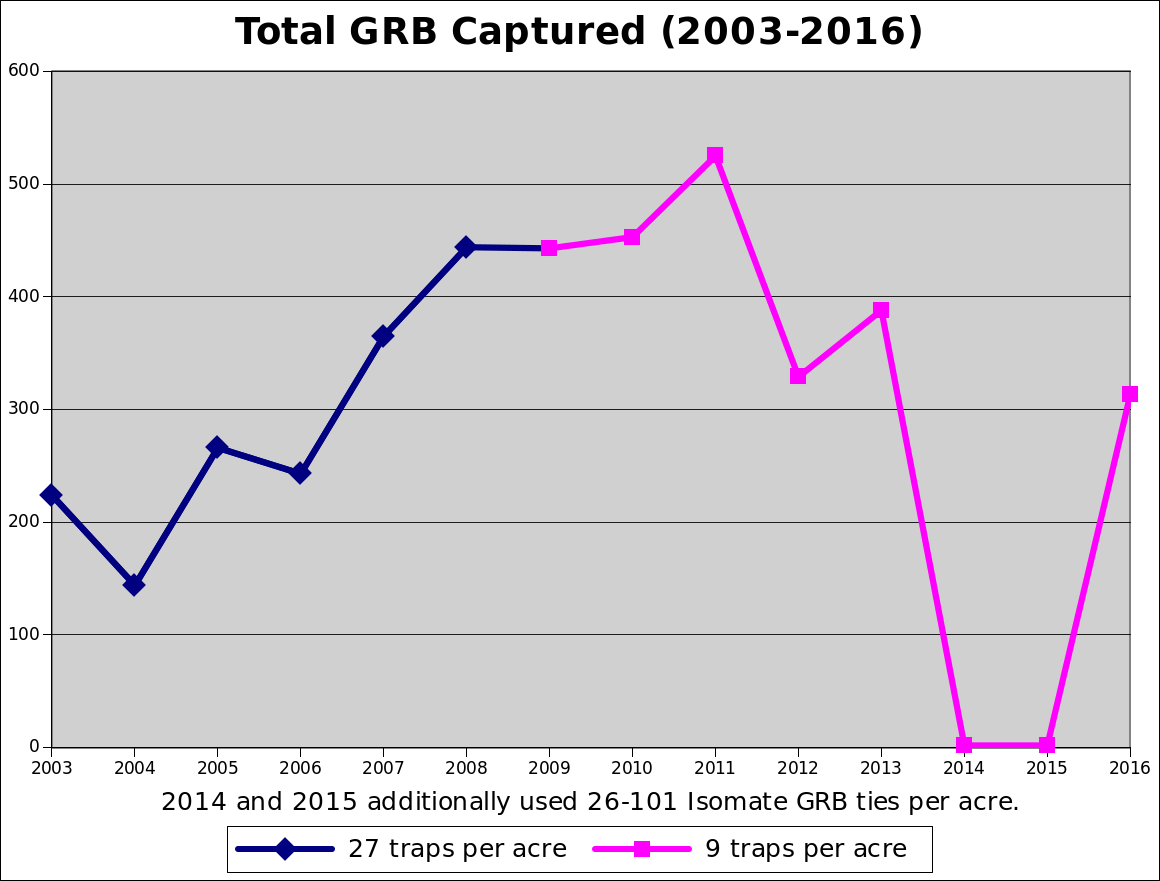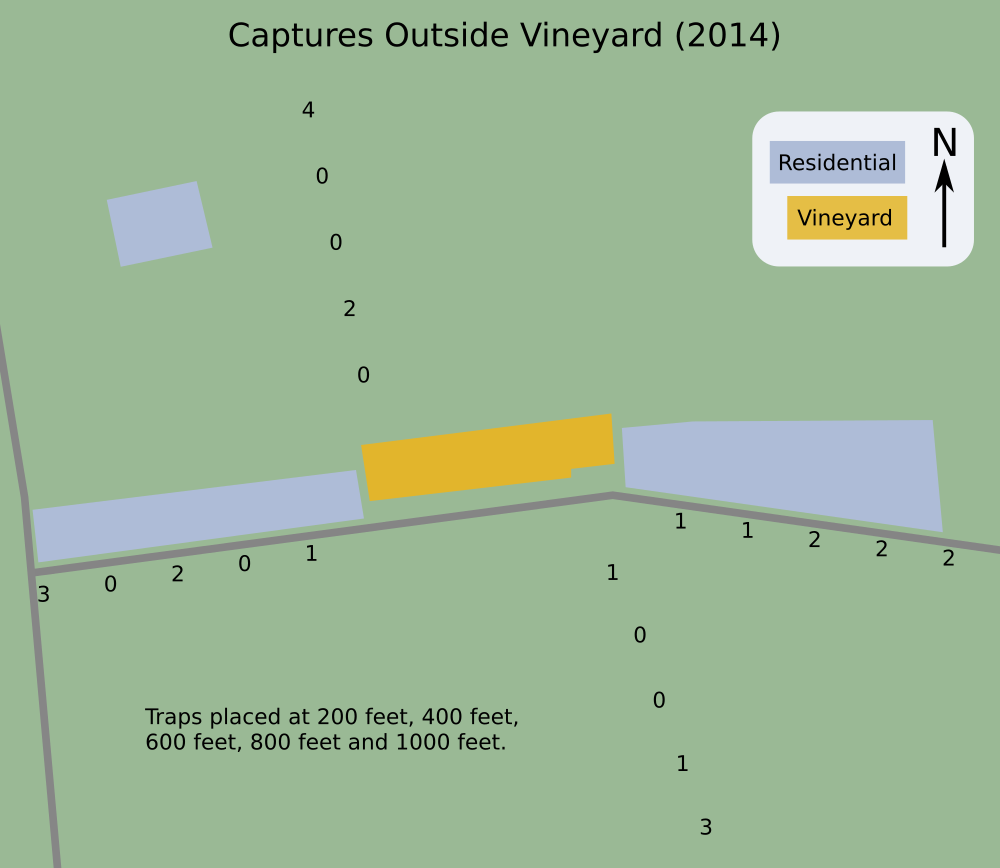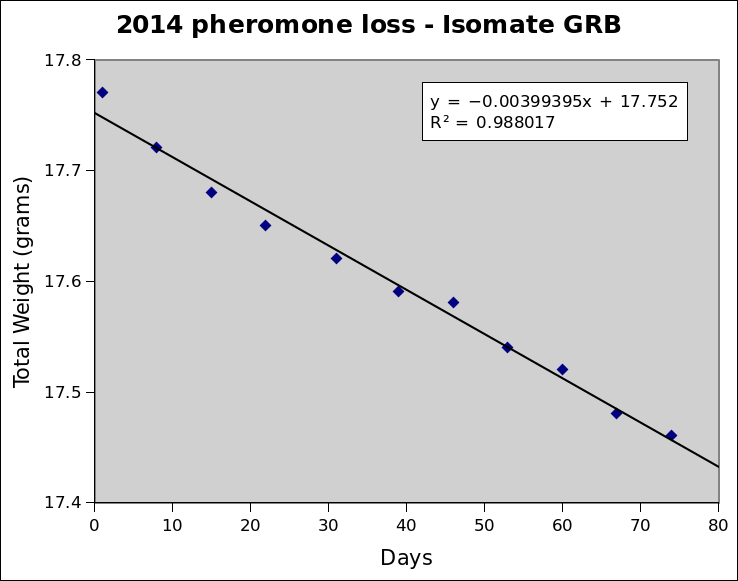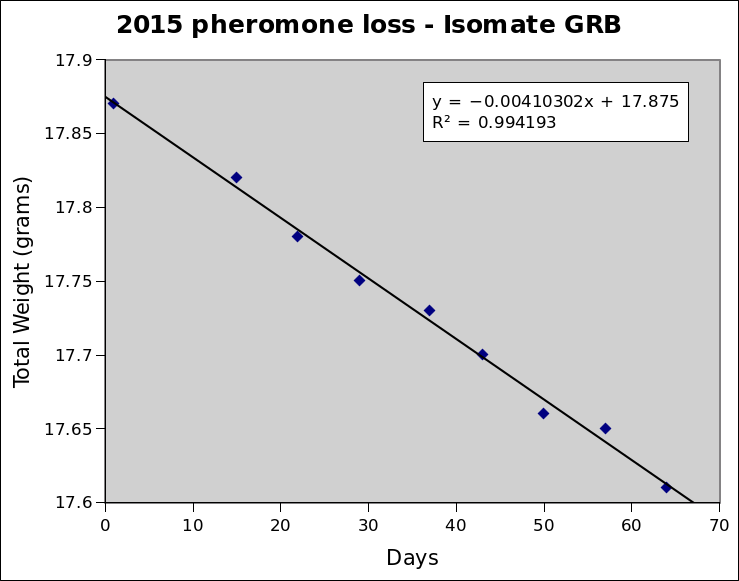Experiments between 2014 and 2016
NE – SARE funded experiment 2014 – 2016
A new experiment was initiated to test the effectiveness of Isomate® GRB in our vineyard with funding from NE-SARE. Several factors made our vineyard a good choice for testing. The vineyard is almost entirely surrounded by farmland. The closest vineyard of any size is just over 5 miles away. The closest wild grapevine is over 1000 feet from the vineyard and the closest woodland that could support more wild grapevines is over a 1/3 of a mile away. There are residences at either end of the vineyard. Monitoring of grape root borer populations with the same system has occurred since 2003, giving an unprecedented record of population levels. Almost the entire vineyard has been divided into a randomized complete block design since 2003 for grape root borer testing and experimentation.
The goals of this experiment were fourfold. First, determine if Isomate® GRB is effective in mating disruption. Second, attempt to ascertain if lower numbers of twist ties than the labeled amount will achieve mating disruption. Third, calculate the rate of pheromone loss from Isomate® GRB twist ties. Finally, does the effectiveness of Isomate® GRB extend beyond the test area.
A randomized complete block design was first established in the vineyard in 2003 and the same layout has been used since. For this study the vineyard was divided into 9 blocks of 11664 square feet each, measuring 72 feet by 162 feet. Each block is subdivided into 3 plots. Each plot is 3888 square feet, measuring 54 feet by 72 feet. With a total of 27 plots there were 9 replicates of three different treatment levels. Treatment levels were randomly selected using a ten thousand random digit table. A standard moth trap (green top, yellow midsection and white bucket) with an EZ:ZZ pheromone lure was placed in the center of each plot at a height of approximately 66 inches above the ground.
The pheromones in Isomate® GRB are based on those secreted by the female European leopard moth (Zeuzera pyrina L.) and the currant clearwing (Synanthedon tipuliformis Clerck), not the grape root borer. Active ingredients are E,Z-2,13-octadecadien-1-ol acetate or EZ and E,Z-3,13-octadecadien-1-ol acetate or EZ-3 in a ratio of 95:5. The major pheromone for the grape root borer, European leopard moth and the currant clearwing is the same but the secondary compound is different. The twist ties are made by the Shin-Etsu Company of Japan and each twist tie contains 80.43 milligrams of pheromones. High concentrations of Isomate® GRB pheromones are meant to confuse the male grape root borers. For grapes the labeled amount is 100 twist ties per acre and the twist ties are to be placed on the lower training wire or mid-canopy in a uniform pattern across the vineyard.
In 2014 and 2015, pheromone traps were placed outside of the vineyard to see if trap shutdown extended beyond the vineyard and to check if male grape root borer moths from the vineyard could be attracted to traps placed outside of the treatment area. Traps were placed at 200, 400, 600, 800 and 1000 feet beyond the edge of the vineyard in four directions to account for changes in wind direction. The directions were close to due north, east, south and west. Traps placed to north were along a tree line between fields of alfalfa, corn and/or soybeans. To the east and west, the traps were along a road and placed in fields of corn or Sudan grass. Traps placed to the south were placed along a grass waterway in a field of corn. All the standard traps with an EZ:ZZ lure were suspended from iron rods at a height of approximately 58 inches above the ground.

Results
2014
Standard moth traps were placed in the vineyard on June 19, 2014. Isomate® GRB twist ties were placed in the vineyard on July 1, 2014. No moths had been captured in the traps to this point, but one male moth had been seen around a trap on June 30th. Isomate® GRB twist ties were placed in the vineyard at three different concentrations. The initial concentrations of Isomate® GRB were nine plots with no twist ties, nine plots with 2 twist ties each, equal to 22 per acre, and nine plots with 5 twist ties, equal to 56 per acre. The average number of twist ties in the test area was 26 per acre. On July 12, 2014 a male moth was captured in one of the plots with no twist ties. The concentration of the twist ties was increased the same day to an average of 52 twist ties per acre in the test area. There were now nine plots with no twist ties, nine plots with 5 twist ties each, equal to 56 per acre, and nine plots with 9 twist ties, equal to 101 per acre.
Again a male moth was captured in a plot with no twist ties on July 18th. Twist ties were now added to the plots that previously had no twist ties. The number of twist ties was increased the same day to an average of 78 twist ties per acre in the test area. There were now nine plots with 5 twist ties each, equal to 56 per acre, nine plots with 7 twist ties each, equal to 78 per acre, and nine plots with 9 twist ties, equal to 101 per acre. No male moths were captured in a trap for the rest of the season, but a mating pair was observed on July 26th at 4:10 PM in a low density (56/acre) plot 14.5 feet from an Isomate® GRB twist tie.
2015
In 2015, standard moths traps with an EZ:ZZ lure were placed in the center of each plot on June 19th. The following day Isomate® GRB twist ties were placed in the vineyard at the same concentrations that were in place at the end of testing in 2014 for an average of 78 twist ties per acre in the test area. Each plot’s concentration was randomly reselected using a ten thousand random digit table. Nine plots contained 5 twist ties each, equal to 56 per acre, nine plots contained 7 twist ties each, equal to 78 per acre, and nine plots contained 9 twist ties, equal to 101 per acre. On July 13th, a male moth was captured in a plot with 5 twist ties. The same day the concentration of Isomate® GRB dispensers was increased to 9 twist ties per plot for the entire test area. The concentration of twist ties was now at the recommended level of 100 per acre. A mating pair of grape root borers was observed on July 21st at 4:40 PM just 9.3 feet from an Isomate® GRB twist tie.
2016
In 2016, no Isomate® GRB twist ties were placed in the vineyard. Standard moth traps with an EZ:ZZ lure were placed in the center of each plot on June 24th. On July 5, the first male grape root bores were captured, four in number. The greatest number of root borers was counted on July 18th with a total of 97. The last two were captured on August 12. A total of 313 male grape root borers were captured in the vineyard during 2016.
Statistical analysis of the results varied. If the total grape root borers captured in 2016 is compared to the totals captured from 2009 to 2013, when 27 traps were also used, the number captured in 2016 is significantly different at a 5% level using a two tailed single sample t test. When the results from 2016 are compared to the total captures for 2003 to 2013, no significant difference was found using a two tailed single sample t test. Statistical tests were done using vassarstats.net.

| Single sample t-test from vassarstats.net |
|---|
| GRB captured in 2016 compared to 2009-2013 (5 years) |
| • significant reduction in total GRB captured |
| • 5% level of significance (P = 0.025) |
| GRB captured in 2016 compared to 2003-2013 (11 years) |
| • no significant difference at 5% level |

Isomate® GRB range outside of vineyard
2014
In 2014 male grape root borers were captured in the traps placed outside of the vineyard. At 200 feet, 3 were captured, at 400 feet-3, at 600 feet-4, at 800 feet-3 and at 1000 feet, 12 were captured. The low numbers captured at 200 to 800 feet would most likely be moths in the general area of the traps and would indicate that moths were not leaving the vineyard. It would also indicate that trap shutdown does not extend beyond the vineyard. A Tukey’s HSD test on the trap captures based on distance from the vineyard showed the number captured at 1000 feet was significantly greater than all the other distances at a 5% level. There was no statistical significance based on the direction using a one-way ANOVA. Statistical tests were done using vassarstats.net.

| Distance from Vineyard (2014) | ||
|---|---|---|
| Tukey’s HSD Test | ||
| Least Significant Difference: 1.98 | ||
| Treatment (feet) | Mean | |
| 200 | 0.75 | A |
| 400 | 0.75 | A |
| 600 | 1.00 | A |
| 800 | 0.75 | A |
| 1000 | 3.00 | B |
| 5% level of significance | ||
2015
Male grape root borers were also captured in the traps placed outside of the vineyard in 2015. At 200 feet, 8 were captured, at 400 feet-6, at 600 feet-2, at 800 feet-5 and at 1000 feet, 13 were captured. More grape root borers were captured at 200 feet than in 2014, but the numbers were still fairly low based on the hundreds that were previously captured in the vineyard. Again this would indicate that moths were not leaving the vineyard and trap shutdown did not extend beyond the vineyard. No statistical significance was found in 2015 in either the distance from the vineyard or the direction of the traps using a one-way ANOVA. Statistical tests were done using vassarstats.net.

Pheromone Loss
2014
The loss of the pheromone mixture from Isomate® GRB twist ties was recorded in 2014 and 2015 at a site 8.5 miles from the vineyard. A total of 16 twist ties were tested. Four sets of four ties each were weighed weekly. Each twist tie contains 80.43 milligrams of the European leopard moth pheromone mixture. In 2014, over the course of 73 days, each twist tie lost on average 20 milligrams or 25% of the Isomate® GRB pheromones. The daily loss was approximately 0.274 milligrams per day per twist tie. During the 73 day testing period, the average daily high temperature was 80.5°F. The highest temperatures were 4 days of 90°F.

2015
Similar results were recorded in 2015. In 2015, over the course of 63 days, each twist tie lost on average 16 milligrams or 20% of the Isomate® GRB pheromones. The daily loss was approximately 0.254 milligrams per day per twist tie. During the 63 day testing period, the average daily high temperature was 82.7°F. The highest temperatures were 3 days of 91°F and 2 days of 90°F. Although the average high temperature was greater in 2015, the loss of pheromones was basically at the same rate as in 2014. In our region the Isomate® GRB twist tie would definitely have sufficient pheromones to last the entire season of grape root borer activity.
These results compare favorably with testing done in 1987 on the Shin-Etzu twist ties in Arkansas. In these tests, twist ties with 40 milligrams of EZ lost 0.23 milligrams per day and twist ties with 40 milligrams of ZZ lost 0.19 milligrams per day. 1

Discussion & Conclusions
In general the proper testing of pheromone based products is very difficult and creates its own special problems. First of all, pheromones are volatile and do not remain in the test area. Airflow can carry the pheromones unknown distances that might have an effect on the target insects in the area. It is unknown from what distance an EZ:ZZ pheromone lure can attract a male grape root borer.
Separate vineyards should be established for each treatment and the control. Ideally vineyards for testing should be planted at the same time, with identical layout and vines, be the same size and located in the same geographical area with the same topography and soils. The vineyards would have to be far enough apart that pheromones from one do not affect the other vineyards. The vineyards would also have to be of a sufficient age that suitable populations of grape root borers are present.
Populations of grape root borer vary naturally from year to year due to unknown environmental factors that are not quantified. In our own vineyard, populations varied with no treatment applied. In the four years of 2003 through 2006, the average number of male grape root borers captured per year was 219. During the four years of 2008 through 2011, the average was 466. Was the increase solely due to rising population levels or was another factor also present? In the two years following 2011, the average number captured decreased to 359. This is a substantial decrease and there is no known reason for it to occur.
In this study, the number of Isomate® GRB twist ties required for mating disruption could not be determined. This was due to the volatility and movement of the pheromones between plots. Trap shutdown did occur at a much lower number of twist ties than the labeled 100 per acre. Even at 25 twist ties per acre trap shutdown was occurring, but trap shutdown does not mean mating disruption is occurring. Ideally, separate vineyards would be required to adequately test the number of twist ties required as previously explained. The number of twist ties required to obtain mating disruption has never been determined. The labeled requirement of 100 per acre appears to based on previous studies with Isonet® Z that used 100 per acre and not on any scientific results. No published study to date, other than the currant NE-SARE project, has used Isomate® GRB. Three earlier studies in 1986 through 1989 all used 100 twist ties per acre with different pheromone combinations than that found in Isomate® GRB. 2 3 4 Isonet® Z twist ties have been used in studies from 2003 to 2011. 5 6 7
The number of male grape root borers captured in the standard traps did decrease with Isomate® GRB. In 2016, 313 were captured as compared with 388 in 2013, the year before the use of Isomate® GRB. Statistical results were inconclusive. If the total grape root borers captured in 2016 is compared to the totals captured from 2009 to 2013, when 27 traps were also used, the number is significantly different at a 5% level using a two tailed single sample t test. When the results from 2016 are compared to the total captures for 2003 to 2013, no significant difference was found using a two tailed single sample t test.
The influence of Isomate® GRB did not extend beyond the vineyard. Low levels of male grape root borers were captured in standard pheromone traps just 200 feet from the vineyard and would also indicate the moths within the vineyard are not attracted to traps placed outside the vineyard. The presence of female moths, Isomate® GRB and other pheromone traps in the vineyard would seem to keep the moths within the vineyard. The higher number of moths captured at 1000 feet south of the vineyard might indicate they could be attracted from at least 1100 feet away, the closest source of wild vines and permanent vegetation to that trap.
The rate of pheromone loss from Isomate® GRB twist ties is slow enough that they will easily last a season. In 2014 the loss was 0.274 milligrams per day and in 2015 the loss was 0.254 milligrams per day. At that rate, on average, half of the pheromone mixture would be gone after 152 days.
To fully evaluate the effectiveness of Isomate® GRB, the project should continue another year. Unfortunately SARE projects cannot extend beyond three years. Other sources of funding could not be found that would continue the experiment for another year.
Like many pheromone studies, this experiment gave inconclusive results. The number of male grape root borers captured did decrease after the use of Isomate® GRB. With one data set the results were statistically significant, but with a different data set the results were not statistically significant. Various unknown environmental factors could also be partly responsible for any variation in the population.
Johnson, Donn T., Barbara A. Lewis, and J. Wendell Snow. 1991. Control of grape root borer (Lepidoptera: Sesiidae) by mating disruption with two synthetic sex pheromone compounds. Environ. Entomol. 20(3): 930-934.↩︎
Williams, R. N., and J. L. W. Keularts. 1989. Occurrence and control of Vitacea polistiformis (Harris) (Lepidopter: Sesiidae) in Ohio vineyards. Ohio J. Sci. 89(2):4.↩︎
Webb, S. E. 1991. Management of grape root borer in Florida with a pheromone. Proc. Fla. State Hort. Soc. 104:3-5.↩︎
Johnson, Donn T., Barbara A. Lewis, and J. Wendell Snow. 1991. Control of grape root borer (Lepidoptera: Sesiidae) by mating disruption with two synthetic sex pheromone compounds. Environ. Entomol. 20(3): 930-934.↩︎
Johnson, D. T., C. R. Roubos, T. W. Nyoike, L. L. Stelinski, and O. E. Liburd. 2013. Lures, Mating Disruption and Mass Trapping of the Grape Root Borer. Acta Hortic. 1001:129-137.↩︎
Pfeiffer, D. G., C. A. Laub, T. A. Jordan, A. K. Wallingford, and M. Cassel. 2010. Control of grape root borer using mating disruption – 2009. Proceedings of 85th Cumberland-Shenandoah Fruit Workers’ Conference, 19-20 November 2009, Winchester, VA. pp. 35-36.↩︎
Weihman, S. W., and O.E. Liburd. 2006. Mating disruption and attract-and-kill as reduced-risk strategies for control of grape root borer Vitacea polistiformis (Lepidopter: Sesiidae) in Florida vineyards. Fla. Entomol. 89(2): 245-250.↩︎